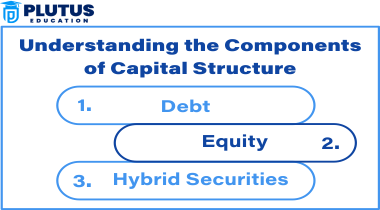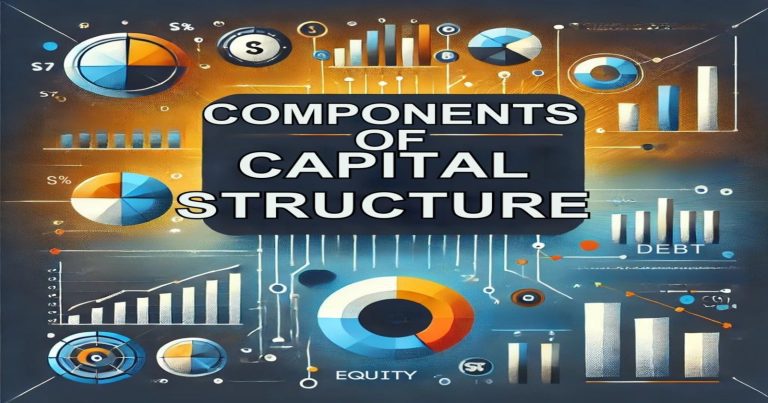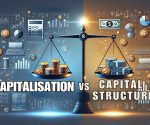A company’s capital structure is one of the most important factors that determine its financial stability and growth. The components of capital structure are the various sources of finance that a company uses to fund its operations and growth. These sources include equity, debt, and hybrid instruments, each playing a unique role in shaping the company’s financial framework. Understanding these components helps businesses balance financial risks and returns effectively.
What is Capital Structure?
Capital structure refers to the way a company finances its operations and growth through various sources of funds. It includes a mix of equity, debt, and hybrid securities, all of which have distinct features and implications for the company’s financial health. The concept of capital structure is central to financial management because it directly affects the overall financial risk and cost of capital. Companies aim to create an optimal capital structure that minimizes risk while maximizing shareholder value. To achieve this balance, managers consider a variety of internal and external factors, which we will explore later in this article.
Capital Structure Definition
The capital structure definition is pretty simple. it is the composition of equity, debt, and hybrid instruments that a firm uses to fund its operations and investments. Funds raised from shareholders are equity while loans and bonds are debt. Hybrid instruments, on the other hand, combine elements of both equity and debt. An optimal capital structure strikes the right balance between the cost of financing and financial risk. This would enable the company to reach its strategic objectives without compromising its financial health. It would also determine the company’s risk profile as well as its potential to raise future investments based on the balance between equity and debt.
Components of Capital Structure
The components of capital structure are the backbone of any company’s financial planning and strategy. It is a means through which a business finances its operations and growth through the use of different sources of funds. There is always a question raised as to which component of capital structure determines the overall financial risk. These include equity capital, debt capital, and hybrid instruments, each having different features and roles in the attainment of financial stability.

Equity Capital: Ownership-Based Financing
The Capital raised from shareholders represents the equity capital. Those equities sold to investors have claims to the ownership of the company and may also vote on corporate decisions besides earning returns through either dividends or capital appreciation.
Role of Equity in Capital Structure
Equity capital is also a permanent source of financing and is not paid back, like debts. It builds up financial foundations for companies, enhances their creditability, and eventually creates financial stability. However, equity is costly too because investors have huge returns demands, plus the issue of more shares in the company can dilute previous ownership.
Some Examples of Equity Capital
There are two main forms of equity capital. These are common shares and retained earnings. Common shares are a form of direct ownership and ownership rights. Retained earnings, on the other hand, form part of the undistributed profits reinvested into the business. After these, the companies make use of equity capital for growth and stability. Therefore, it is one of the cornerstones of their financial policy.
Debt Capital: The Borrowed Funds for Growth
This includes loans borrowed from other creditors such as bondholders, banks, and others. The money is borrowed with a principal that the company must repay with interest. Debt financing remains one of the most common means of funding used by companies today because it ensures that companies acquire large sums immediately.
- Advantages of Debt Capital: Debt financing is less costly. The interest on debt is tax-deductible, which means that the cost of funding is reduced. Debt also allows companies to retain ownership and control since lenders do not participate in decision-making.
- Advantages of Debt Financing: Debt contains fixed obligations related to repayment. Shortfalls in revenues can make it challenging for the company to meet these obligations. Large amounts of debt can also constrain flexibility and increase a firm’s ability to obtain future credits. Hybrid examples of capital include commercial loans and corporate bonds, both of which are indispensable to large-scale operations and expansion.
Hybrid Instruments: Mix of Equity and Debt
Hybrid instruments are financial instruments having feature both equity and debt. These instruments enable the flexibility needed for raising funds by both business companies and bringing the best of elements together. Hybrid instruments can be mainly: convertible bonds and preference shares.
Features and Benefits of Hybrid Instruments
Hybrid instruments give fixed returns similar to debt so high-risk investors use hybrid instruments. Besides, in certain hybrid instruments, under certain circumstances, these hybrid instruments can be changed into equity which will yield the prospect of future ownership. Hybrid instruments from the company perspective balance between risk and return; it offers a more flexible arrangement concerning finance and more diversified investors are attracted.
Disadvantages of Hybrid Instruments
Hybrid instruments are a very complex configuration and management device. Their equity conversion may lead to diluted ownership; regulatory compliance is usually more expensive. However, their flexibility in capital structure makes them the ideal choice for companies undertaking dynamic markets.
| Component | Definition | Key Features | Advantages | Disadvantages | Examples |
| Equity Capital | Funds raised from shareholders in exchange for ownership | A permanent source of funding does not require repayment, and shareholders bear the business risk | No fixed repayment obligations improve creditworthiness, reduce reliance on debt | Dilutes ownership, higher cost compared to debt, dividends are not tax-deductible | Common shares, Retained earnings |
| Debt Capital | Borrowed funds from external sources, repayable with interest | Fixed repayment terms, interest payments are tax-deductible, increase financial leverage | Lower cost due to tax benefits, quick access to large funds, no dilution of ownership | Fixed obligations increase risk, excessive debt reduces flexibility, risk of financial distress | Bank loans, Corporate bonds |
| Hybrid Instruments | Financial instruments combining features of equity and debt | Offers fixed returns like debt, can include ownership rights like equity, convertible in some cases | Balances risk and return, attracts diverse investors, flexible financing option | Complex to structure and manage, conversion may dilute ownership, regulatory compliance costs | Convertible bonds, Preference shares |
Factors Affecting Capital Structure
The factors of capital structure are the fundamental components that determine a company’s financial framework. These elements include equity capital, debt capital, and hybrid instruments, which together form the basis of funding operations and growth while balancing risk and returns.
Why Capital Structure Matters
The three elements of a capital structure hold an important place in determining how healthy and whether a company would grow. All three components, including equity, debt, and hybrid instruments, have unique advantages businesses can draw on to meet their purposes successfully.
Benefits of a Balanced Capital Structure
An ideal capital structure minimizes financial risks and ensures adequate funding for business activities. It reduces the cost of capital, improves operational efficiency, and enhances investor confidence. By maintaining the right mix of components, companies can adapt to market changes and seize growth opportunities.
Long-term impacts
A well-thought-out capital structure will lay the groundwork for long-term success and sustainability. Companies with a good capital structure can face economic downturns, attract investments, and pursue strategic initiatives without compromising financial stability.
Determinants of Capital Structure
Determinants of capital structure include strategic and operational considerations that shape a company’s financing decisions. The determinants play a crucial role in achieving financial efficiency.
- Nature of the Business: Capital-intensive industries such as manufacturing rely heavily on debt financing, while service-based industries prefer equity due to lower capital requirements.
- Size of the Company: Larger companies have better access to capital markets and can achieve favorable terms for both debt and equity financing.
- Management Preferences: Some management teams prioritize control and prefer equity financing, while others focus on cost-effectiveness and prefer debt.
- Profitability: High-profit firms can exploit internal sources such as retained earnings for financing, thus having less need to venture in external financing.
- Industry Norms: Industry benchmarks and praxis shape a firm’s capital structure decisions.
Importance of Capital Structure
Capital structure is important because it enhances a firm’s efficiency in its operation and financial stability. It also affects a firm’s risk profile and long-term growth. The capital structure significance is listed below:-
- Risk Management: The ideal capital structure is that which reduces financial risk through an optimal mix of equity and debt. This way, the firm is safeguarded in case of a recession.
- Cost Efficiency: The cost of capital is optimized. More funds can be directed toward growth and innovation.
- Investor Confidence: A sound capital structure builds investor confidence and future investments.
- Flexibility: A flexible capital structure gives the firm a chance to act quickly in responding to market opportunities and challenges.
Components of Capital Structure FAQs
What are the components of capital structure?
The components of capital structure include equity capital, debt capital, and hybrid instruments. Each component plays a unique role in financing a company’s operations and growth.
Which component of capital structure determines the overall financial risk?
Debt capital determines the overall financial risk. Excessive debt increases the risk of default and financial distress.
Why is capital structure important?
Capital structure is important since it affects a company’s financial health, risk profile, and cost of capital. It ensures long-term stability and operational efficiency.
Which factors affect the capital structure?
Business risk, cost of capital, financial flexibility, tax benefits, market conditions, and growth opportunities are the factors that influence capital structure.
What is capital structure?
It defines the capital structure of a company, which is composed of equity, debt, and hybrid instruments in financing its operation and growth.


